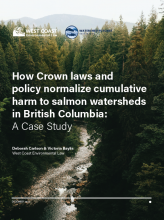
Wild salmon in British Columbia are in a perilous state. In many salmon watersheds, the freshwater and estuarine regions that are vital for spawning and rearing have been severely altered through the “death by a thousand cuts” of modern urban and industrial activities, and now climate change.
Addressing cumulative effects in these ecosystems is key for salmon stewardship – and to move forward, we need clarity and accountability about how existing Canadian and BC laws and policies are contributing to the problem. That’s why West Coast Environmental Law co-authored a new report with the Watershed Futures Initiative, using a case study on stream crossings to explore how Crown laws and policies are currently failing salmon, and what needs to change.
The report focuses on the impacts of stream-crossing or stream-spanning structures from BC highways, forest roads and dikes, which are regulated and managed by federal and provincial authorities. These activities have wide-ranging effects – from barriers to fish passage to diminished water quality, inadequate flows, and more.
Our analysis looks at the laws and policies that govern “routine” decisions and the relatively local impacts that accumulate over time and space, adding up to significant harms in salmon watersheds. We found these cumulative effects are not being tracked or managed as part of the regulatory process. Instead they are “normalized” and tolerated as an embedded trade-off in existing laws. We found this residual harm needs more attention and accountability.